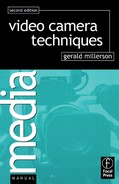Your camera’s viewfinder is a vital link in good picture-making:
• It shows exactly how much of the scene is visible in the shot – to ensure that no unwanted subjects (e.g. the microphone, or bystanders) are accidentally included within the picture.
• It enables you to arrange the shot accurately within the frame, composing the picture for maximum impact.
• It shows you exactly how much of the shot is sharply focused.
• It helps you to judge exposure and picture quality as you shoot.
• It can help when matching shots to other cameras; e.g. by showing their outputs combined with your own picture.
• Particularly when working in the field, it can be useful to monitor videotape playback of the scene you have just recorded.
Most video cameras are fitted with an electronic viewfinder of some kind. The eyepiece type — This is fitted with a small magnified black and white picture tube (typically 1.5 in./38 mm diam.). You hold its flexible eyepiece against one eye, adjusting a compensatory lens to suit your eyesight. The viewfinder may be repositioned on top or on either side of the camera.
The open-screen type — Fitted on top of the camera head you use both eyes to view this 5 or 7 in. monitor (12.5 or 18 cms.) so it is less tiring to watch for long periods. Tilting the viewfinder makes it easier to see at different camera heights. A hooded visor keeps stray light from falling onto its picture. Monochrome viewfinders are generally used, as they allow more critical focusing. But color versions do have advantages – allowing you to check the picture’s color quality, assess color relationships, pick out color clues (e.g. a particular team’s shirts in a ball game), avoid colored lens flares.
The LCD screen — Small liquid crystal displays are thin, lightweight, and use little power. Although clarity and color quality are not high, the LCD screen is often much more convenient than a color monitor in the field.
The main viewfinder controls usually include screen brightness, screen focus, contrast (which increases/decreases tonal differences), crispener (which emphasizes viewfinder detail, to make focus adjustments easier to see). A color viewfinder also includes color strength adjustments (saturation). Remember, these controls only affect the viewfinder’s picture, leaving your camera’s output unaffected.
Various types of indicators are fitted to video cameras, including the following;
• Autofocusing zone select |
Shows whether the autofocus is controlled by a small central area of the shot, or the nearest subject in the scene. |
• Back light exposure |
A system that opens the lens aperture an arbitrary stop or so above the auto-iris setting, to improve exposure against bright backgrounds. |
• Battery alarm. |
A warning light showing that the battery is OK, or that it is getting exhausted. |
• Boost setting. |
Shows amount of video amplification (gain) being used. |
• Call light. |
Indicator showing that someone on a private-wire system wishes to talk to the camera operator. |
• Date and time indicator. |
Displays details on screen, for insertion into picture. |
• End of tape warning. |
Shows that only e.g. 1 minute of tape remains. |
• Exposure indicator |
A light or pattern superimposed on the viewfinder (e.g. ‘zebra stripes’) showing when the picture is technically over or under exposed. |
• Full-auto indicator. |
Shows that camera is in fully automatic mode (i.e. auto-iris, auto-focus, etc.). |
• Low light level warning. |
Insufficient light falling onto the CCD, causing underexposure. (Open iris and/or increase boost.) |
• Manual aperture setting. |
Shows that the lens is manually controlled. |
• Manual focus correct. |
The lens is manually focused, and correctly adjusted. |
• Moisture and dew. |
Indicates if the VCR system has been subjected to moisture (e.g. condensation) which would ruin the recording (affecting stiction of tape on the scanning capstan). |
• Filter selection |
Shows which filter in filter wheel has been selected. |
• Playback. |
Indicates that the VCR is replaying the tape. |
• Shutter speed. |
Shows which shutter speed has been selected. |
• Tape speed selected. |
Shows whether normal tape speed or half-speed has been selected on the VCR. |
• Tally light. |
A cue light showing that the camera is recording; or when used with a switcher unit, that this camera has been selected ‘on-air’. |
• Time indicator. |
Shows the running time (elapsed time/tape time used) and/or the time remaining on the cassette. |
• Titles. |
A small character generator that provides titles, which can be superimposed on the picture. |
• Video/audio recording. |
Indicates that the VCR is recording picture and sound. |
• Video level. |
A display superimposed on the viewfinder, showing the video signal’s strength and exposure. |
• Viewfinder markers. |
Markings on the screen showing the exact center, and the safe area within which all important information should be contained. |
• White balance. |
Shows if the color balance (color temperature) adjustment is satisfactory. |
